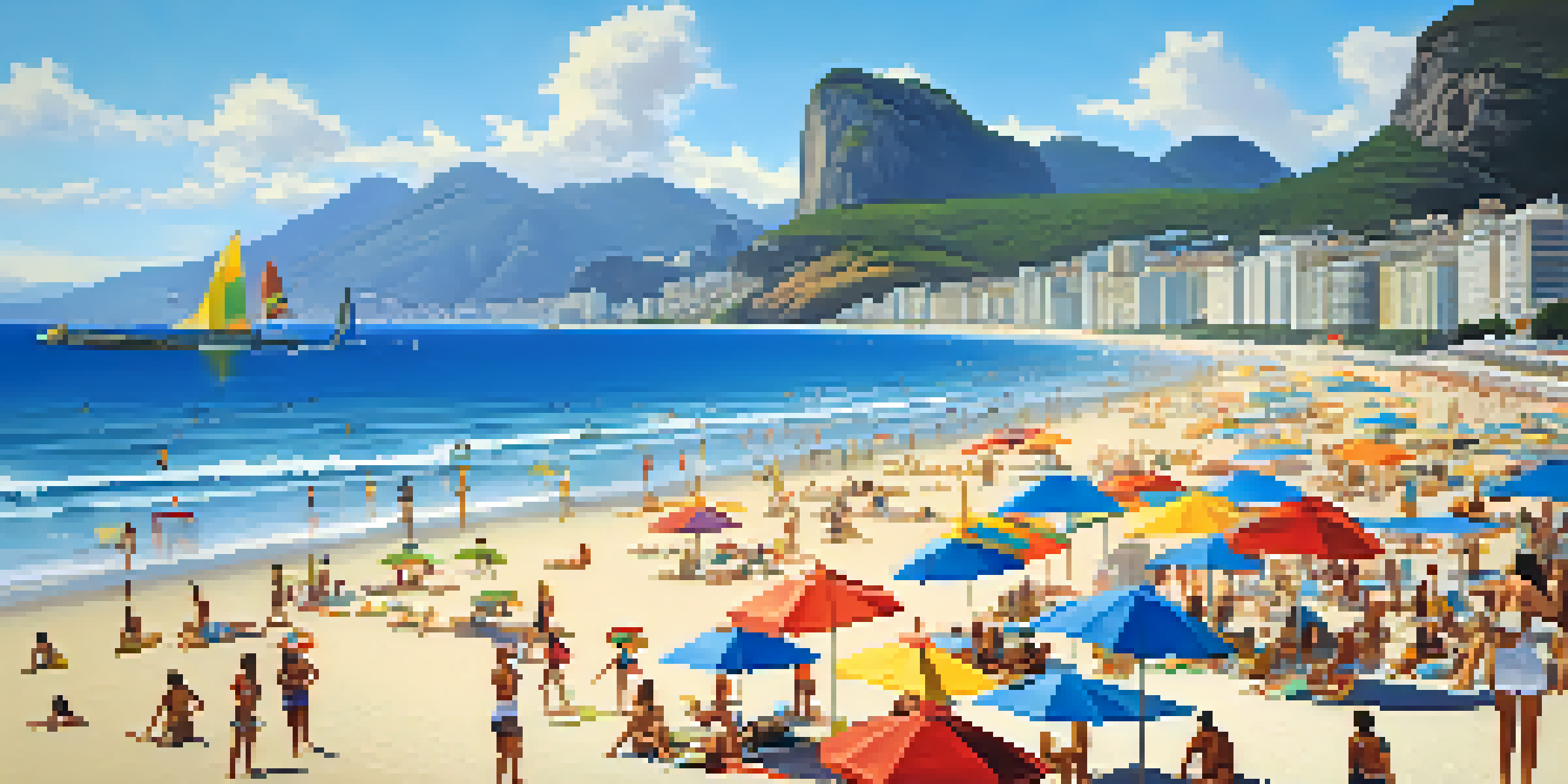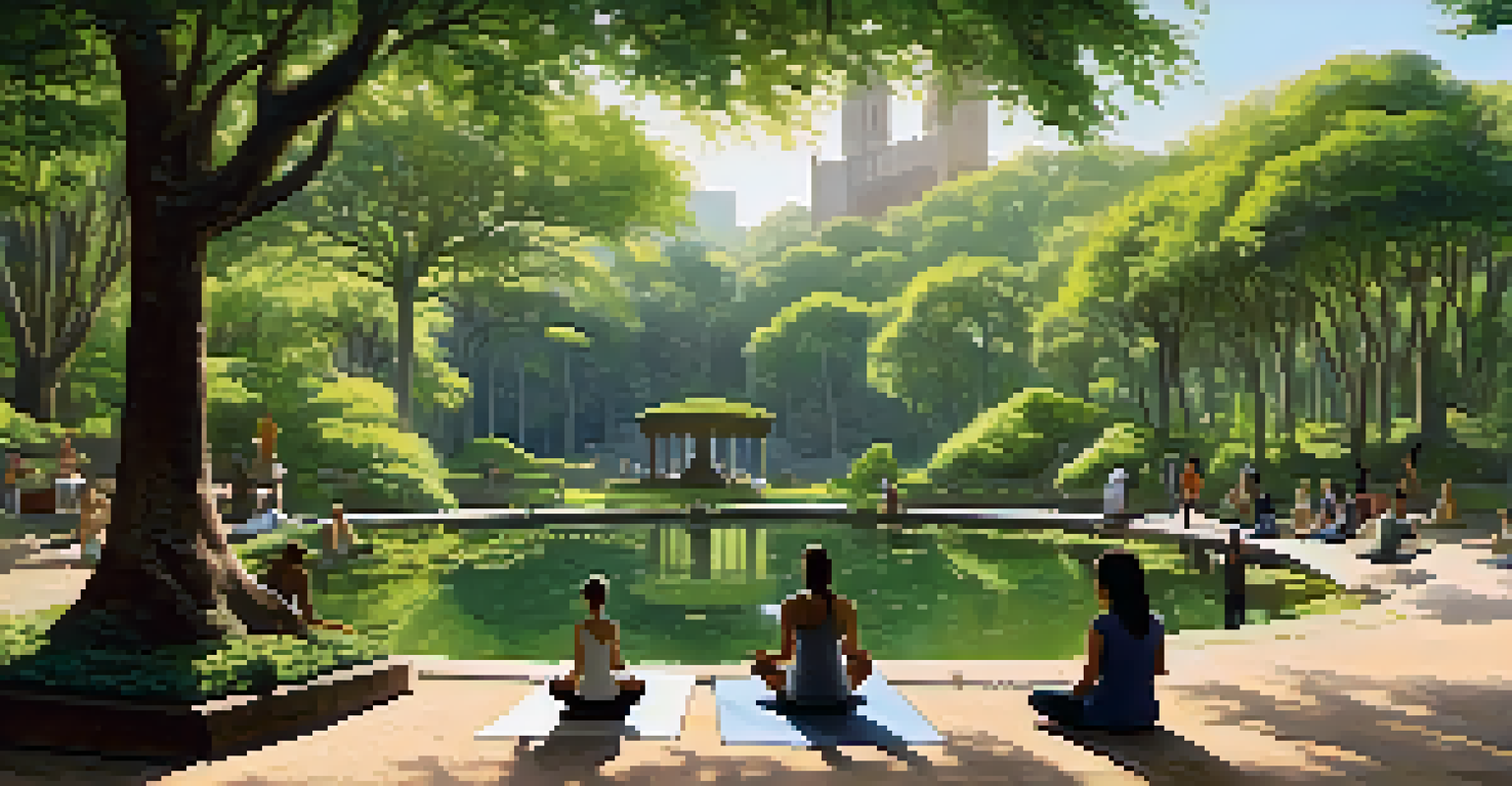Beach vs. Park: Nature's Role in Rio's Urban Life

The Allure of Rio's Beaches: A Coastal Paradise
Rio de Janeiro is famous for its stunning beaches, like Copacabana and Ipanema. These coastal gems attract locals and tourists alike, offering a vibrant atmosphere filled with sun, surf, and sand. The beach is more than just a place to relax; it's a social hub where people gather to enjoy food, music, and each other's company.
The ocean stirs the heart, inspires the imagination, and brings eternal joy to the soul.
The ocean serves as a backdrop for numerous activities, from beach volleyball to surfing. It fosters a sense of community and connection, as people of all ages come together to enjoy the coastal lifestyle. The rhythmic sound of waves creates a soothing ambiance, inviting visitors to unwind and bask in the beauty of nature.
Additionally, the beaches play a crucial role in Rio's economy, supporting local businesses and tourism. The lively beach culture enhances the city's identity, making it a unique blend of urban life and natural beauty. So, while the parks may offer tranquility, the beaches bring energy and life to the urban landscape.
Parks: Green Oases Amidst Urban Hustle
In contrast to the bustling beaches, Rio's parks provide serene escapes from the city's fast pace. Places like Parque Lage and the Botanical Garden offer lush greenery, walking paths, and a chance to reconnect with nature. These parks are perfect for leisurely strolls, picnics, and enjoying the diverse flora and fauna that thrive in these environments.

The parks also serve as venues for cultural events, art exhibitions, and community gatherings, enriching the cultural fabric of the city. They encourage physical activity, with trails for jogging, cycling, and even yoga sessions, promoting a healthier lifestyle. This green space is essential for urban residents seeking balance amidst the concrete jungle.
Beaches: Vibrant Social Hubs
Rio's beaches serve as lively gathering spots for social interactions, activities, and cultural expressions.
Moreover, parks are vital for biodiversity, providing habitats for various species. They play a role in improving air quality and reducing urban heat, making them indispensable in maintaining the ecological health of Rio. Thus, while beaches draw crowds for fun and relaxation, parks offer a peaceful sanctuary for reflection and rejuvenation.
Cultural Significance: Beaches vs. Parks
Both beaches and parks hold unique cultural significance in Rio's urban life. The beaches are synonymous with Brazil's lively spirit, encapsulating the essence of 'carnaval' through their vibrant celebrations and social interactions. They are places where the city's cultural identity shines, showcasing music, dance, and local cuisine.
In every walk with nature one receives far more than he seeks.
On the other hand, parks often reflect the history and artistry of Rio. Many parks feature sculptures, fountains, and historical monuments, making them living museums that tell the story of the city. They serve as platforms for cultural exchange, where art installations and performances bring the community together.
This interplay of culture and nature fosters a rich urban experience, making Rio a city where every corner tells a story. Whether you're dancing on the beach or admiring art in a park, both spaces contribute to the vibrant tapestry of life in the city. This cultural blend shapes the unique character of Rio, attracting visitors and inspiring residents.
Environmental Impact: Beaches vs. Parks
The environmental impact of beaches and parks cannot be overlooked. Beaches, while beautiful, face challenges like erosion and pollution, which threaten their natural beauty and ecosystems. Efforts to clean the beaches and promote responsible tourism are vital in preserving these coastal treasures for future generations.
In contrast, parks play a crucial role in urban ecology by providing green spaces that support wildlife and biodiversity. They help mitigate urban heat, improve air quality, and offer a refuge for many species. The presence of trees and plants in parks contributes to the overall health of the urban environment, making them essential for sustainable city living.
Parks: Essential Green Spaces
The city's parks provide tranquil retreats that promote health, biodiversity, and community engagement.
Both ecosystems are interconnected, highlighting the importance of balancing urban development with nature conservation. By fostering awareness and responsibility, Rio can maintain its beautiful beaches and lush parks, ensuring that residents and visitors alike can enjoy these natural wonders for years to come.
Activities and Experiences: What Each Offers
The activities available at beaches and parks showcase their distinct offerings. Beaches are perfect for water sports, sunbathing, and beach games, attracting thrill-seekers and sun lovers. The lively atmosphere encourages social interactions, making it easy to meet new people and create lasting memories.
Parks, on the other hand, provide a different set of experiences, focusing on tranquility and leisure. From jogging and cycling to simply enjoying a good book under a tree, parks cater to those seeking peace and relaxation. The variety of flora and fauna also presents opportunities for nature walks and educational experiences, especially for families.
These diverse activities highlight the unique roles that both beaches and parks play in urban life. Whether you're looking to engage in spirited beach volleyball or indulge in a quiet moment of reflection in a park, Rio's natural spaces cater to every preference, enriching the lives of its residents.
Accessibility: Reaching Nature in Rio
Accessibility is a key factor in how residents and visitors experience Rio's beaches and parks. Most of the city's beaches are easily reachable by public transport, making them popular destinations for both locals and tourists. The proximity to urban centers means that anyone can enjoy the sun and surf without much hassle.
Parks, too, are strategically located throughout the city, though some may require a bit more travel. Initiatives to improve public transportation and create pedestrian-friendly pathways have made parks more accessible, encouraging more people to enjoy these green spaces. This accessibility fosters a sense of community as people can easily gather and connect with nature.
Balancing Nature and Urban Growth
Future urban development in Rio must prioritize the preservation of both beaches and parks to maintain the city's unique identity.
In essence, both beaches and parks are integral to Rio's urban landscape, and their accessibility ensures that everyone can experience the benefits of nature. By embracing these natural spaces, Rio not only enhances the quality of life for its residents but also showcases its commitment to promoting a healthy urban environment.
Future Perspectives: Balancing Nature and Urbanization
As Rio continues to grow, the challenge lies in balancing urbanization with the preservation of its natural spaces. The demand for development often puts pressure on both beaches and parks, threatening their existence. Therefore, city planners and environmentalists must work together to find sustainable solutions that prioritize both growth and conservation.
Innovative approaches, such as creating green roofs and urban gardens, can help integrate nature into the urban fabric. These initiatives not only enhance the aesthetic appeal of the city but also contribute to environmental sustainability. Engaging the community in conservation efforts can also foster a sense of ownership and responsibility toward these natural spaces.

Ultimately, the future of Rio's urban life relies on recognizing the importance of both beaches and parks. By embracing their unique attributes and ensuring their preservation, the city can continue to thrive while maintaining its identity as a vibrant urban oasis. This balance will enhance the quality of life for all who call Rio de Janeiro home.